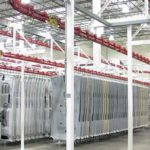Conveyors are the backbone of many factories, moving parts and materials through assembly or processing stations via chains, rollers, belts, or pallets. Most conveyor designs hold the part stationary, in a given orientation, as it moves down the line. And in many processes, maintaining a fixed orientation is important — when a part is being inspected, for example, or being delivered to a robot for assembly. But when the application calls for the part to change orientation between one station and the next, or even to rotate as it’s being conveyed, a chain-on-edge conveyor is often the best option.
Chain-on-edge conveyors allow parts to rotate as they’re conveyed.

A chain-on-edge (COE) conveyor is essentially a single-strand chain conveyor that has been turned 90 degrees, so that it runs on its side. The chain-on-edge design typically uses a roller chain that runs in a channel and is supported by plates. The chain flexes along the horizontal axis, allowing this style of conveyor to make horizontal turns. Vertical curves (height changes) are also possible with the chain-on-edge design, but the curves must be gradual. These turning capabilities make chain-on-edge conveyors much more versatile than traditional chain conveyors.
The key to product rotation in a chain-on-edge conveyor is the use of spindles attached to the chain. The spindles can be designed to rotate freely, to rotate and stop at preset positions (90 and 180 degrees, for example), or to stop at custom positions. Stationary spindles are also an option, and are often used for smaller parts that need to be transported with access to all sides, but not necessarily rotated, during transport.
Chain-on-edge conveyors are sometimes referred to as “spindle conveyors.”
Although their unique feature is the ability to rotate parts during transport, chain-on-edge conveyors are also used for transporting heavy loads that don’t rotate, but that require full access to the outer sides and top of the part. In these applications, the load is carried on a truck, or cart, attached to the chain. For large or asymmetrical loads, the chain is accompanied by external tracks, or outriggers, that help support and guide the load.

Rider plates attach to the chain, and pusher dogs — mechanical latch-type devices that engage and disengage with the trucks — attach to the rider plates. In some chain-on-edge designs, pusher dogs can be used to facilitate product accumulation or transfer from one chain to another.

Applications that call for a product to rotate during transport including painting, coating, curing, cleaning, baking and drying. These applications are found extensively in the automotive industry, but virtually any product with an outer surface that has been painted, coated, or cured has likely been transported by a chain-on-edge conveyor.









Leave a Reply
You must be logged in to post a comment.